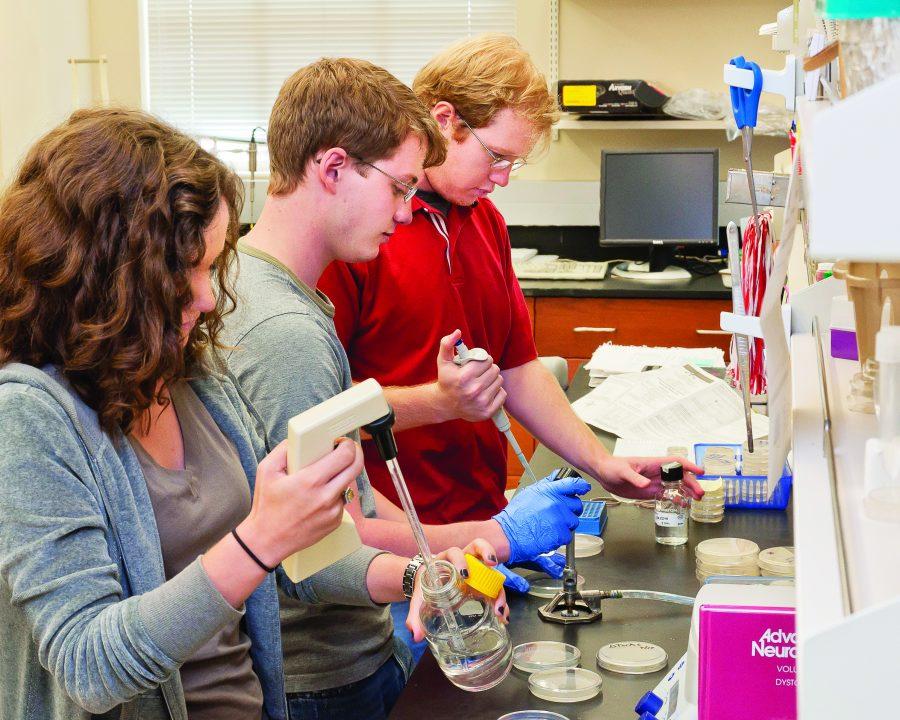University of Alabama scientists, in collaboration with Harvard University, recently published research in “Nature Communications” defining a protein’s role in the neurological disease dystonia. This research subsequently opened the door for new cystic fibrosis research.
Cystic fibrosis is a genetic disease that affects about 30,000 children and adults in the United States, according to the Cystic Fibrosis Foundation’s website. People with CF develop unhealthy amounts of mucus in their lungs and suffer from pancreatic insufficiency. At UA, researchers in the Caldwell Lab, are contributing to CF research.
Guy Caldwell, Professor of Biological Sciences at UA, and his wife Dr. Kim Caldwell, Adjunct Assistant Professor in the Department of Biological Sciences, run the Caldwell lab – the largest lab on campus. Known as The Worm Shack, the lab specializes in research related to neurological diseases such as Parkinson’s, ALS, and Alzheimer’s. While researching the neurological disease dystonia and it’s relation to the protein torsinA, Guy Caldwell and his team found an important connection to another disease, cystic fibrosis.
“TorsinA is a key component of cellular quality control mechanisms,” Caldwell said. “In trying to understand the mechanism by which normal torsinA functions, we wanted to evaluate a known protein that has been well-established as being associated with a failure in quality control – the cystic fibrosis associated gene product, called ‘CFTR.’”
Guy Caldwell explained that an intriguing aspects of the study shows that torsinA can directly interact with defective forms of CFTR and regulate its production.
As a result of their protein study, the lab has been selected for a renewable $110,000 grant from the National Institutes of Health for further cystic fibrosis research.
“Part of our grant is drug discovery and the other is genetics,” Caldwell said.
The lab is working with the UAB Cystic Fibrosis Center, where Birmingham doctors take the research from The Worm Shack and apply it to human cells.
The Caldwell Lab’s website highlights how the lab utilizes the microscopic nematode roundworm, C. elegans, as a model system for discovering gene function, as well as therapeutic target development for those disorders.
“The C. elegans is ideal, because 70 percent of all genes with a genetic link to human disease have a worm homolog,” Guy Caldwell said. “Researchers can observe the effects of diseases and treatments on the worms, and the results are likely to be mirrored in humans.” Another advantage to using these worms is their short lifespan, about two weeks, and rapid reproduction. These advantages allow the lab to quickly test the effects of gene modification and drugs.
Nathan Roberts, a graduate student at the University, and the two undergrad students he mentors began working on the new CF research with the C. elegans worms this past summer. Roberts started researching in the Caldwell Lab during the first semester of his freshman year.
“I found it was an incredible and rewarding project,” Roberts said of his work with dystonia and its later connection to CF.
Caldwell said he is excited that students in The Worm Shack have gotten some great data in only two months. He believes supporting medical research is extremely important because it gets creative minds together to generate new ideas.
“Here we were studying a protein that affects the neurological disorder dystonia, and we said, ‘Hey, maybe this could apply to CF,’” Guy Caldwell said. “By research into one rare neurological disease, we have potentially uncovered an unforeseen avenue toward therapeutic intervention for another much more common disease for which there is not currently a cure either.”
Visit www.cff.org/AboutCF/ for more information about cystic fibrosis, and www.dystonia-foundation.org for more information about dystonia. You can learn more about the Caldwell Lab at bama.ua.edu/~gcaldwel







